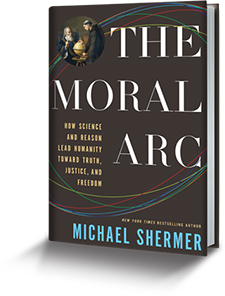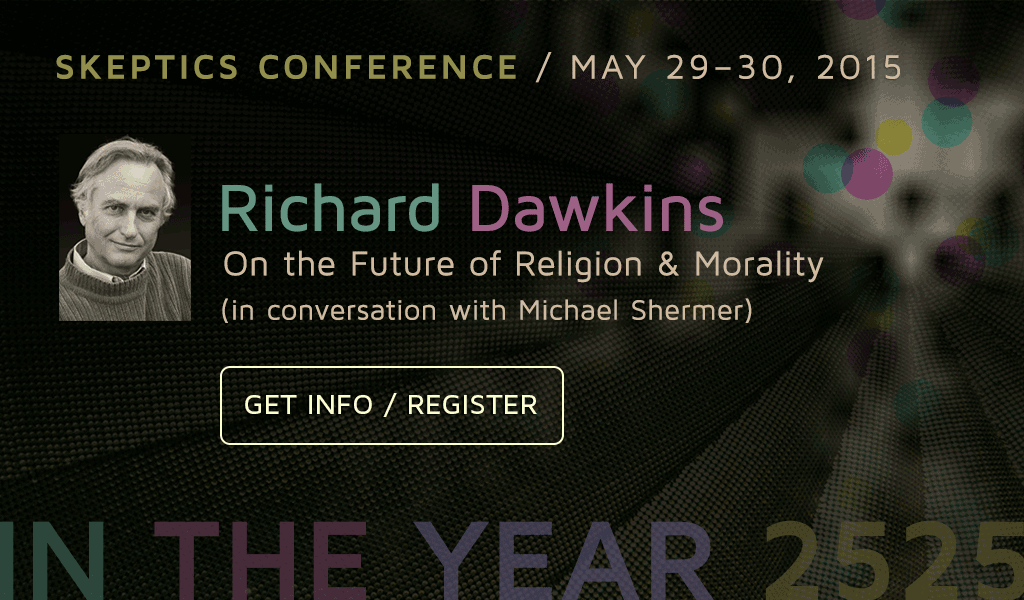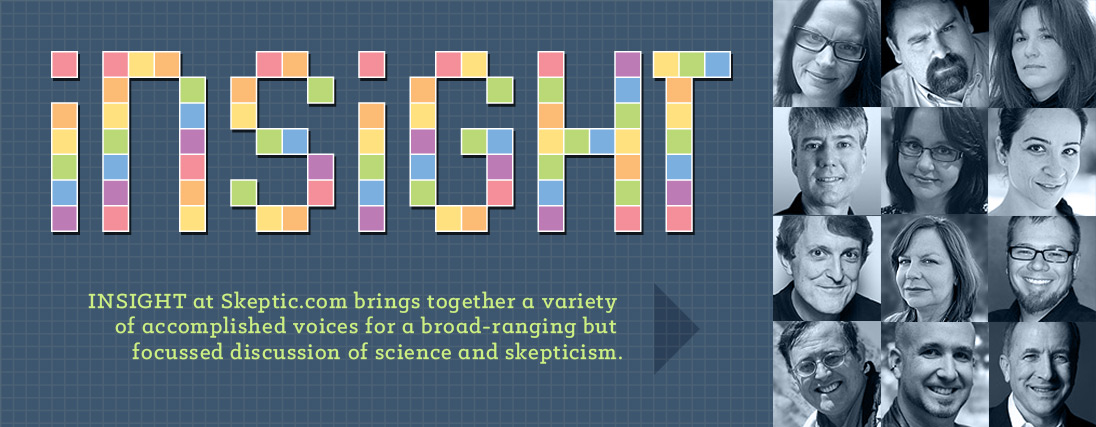In this week’s eSkeptic:
WATCH DR. BETH SHAPIRO’S LECTURE FOR FREE, BROADCAST LIVE FROM CALTECH, THIS SUNDAY @ 2pm
How to Clone a Mammoth:
The Science of De-Extinction
Sunday, May 3, 2015 at 2 pm (PST)
Baxter Hall, Caltech

Credit: Kris Krüg
COULD EXTINCT SPECIES, like mammoths and passenger pigeons, be brought back to life? According to evolutionary biologist Beth Shapiro, the science says yes. From deciding which species should be restored, to sequencing their genomes, to anticipating how revived populations might be overseen in the wild, Shapiro vividly explores the extraordinary cutting-edge science that is being used to resurrect the past. Journeying to far-flung Siberian locales in search of ice age bones and delving into her own research and that of others, Shapiro considers de-extinction’s practical benefits and ethical challenges. Would de-extinction change the way we live? Is this really cloning? What are the costs and risks? And what is the ultimate goal?
A book signing will follow the lecture. We will have copies of the book, How to Clone a Mammoth: The Science of De-Extinction, available for purchase. Can’t attend the lecture? Order the book from Amazon.
TICKETS are available first come, first served at the door. Seating is limited. $10 for Skeptics Society members and the JPL/Caltech community, $15 for nonmembers. Your admission fee is a donation that pays for our lecture expenses.
FROM STONEWALL TO INDIANA
The Collision Between Religious Freedom and Gay Rights
Imagine for a moment that you are a Jewish baker who owns a small bakery. One day a couple enters your establishment and orders a wedding cake to be adorned with swastikas and the likeness of Adolf Hitler. They explain that they are neo-Nazis inspired by the marriage of the Reich Minister of Propaganda Joseph Goebbels, attended by the Führer himself. You are of course offended and decline the job. Is it your legal right to refuse service to a neo-Nazi couple? If you answer in the affirmative, would you apply the same reasoning to a gay couple who requested a wedding cake adorned with two men or two women? Are these not the same moral and legal issues?
I think not. Discrimination on the basis of what you believe versus who you are constitutes different moral categories. For example, I am the publisher of a science magazine called Skeptic, which analyzes controversial claims of various kinds, from creationism and climate change to vaccinations and diets. In the mid 1990s we published an issue of Skeptic that analyzed the claims of self-professed Holocaust “revisionists”—those who believe that six million Jews were not gassed or shot in concentration camps and that the Nazis never intended to exterminate European Jewry. Despite our thorough debunking of their claims, one of the organizations contacted our offices to place an advertisement in the magazine promoting their cause. We declined to accept their business. By contrast, I would not refuse the advertising business of a black or gay organization simply because of the nature of the people running it. The difference is between what someone believes and who someone is.
Historically, the arc of the moral universe has been bending toward justice because we have stopped treating people based on who they are by nature, such as gender, race, and most recently by sexual preference. The recent legal imbroglio over the right of businesses in Indiana and other states to refuse service to people based on their sexual preference (gay versus straight) illuminates how quickly this rights revolution is unfolding. Compared to the abolition of slavery and torture, the granting of the franchise to blacks and women, and the civil rights and women’s rights movements, the gay rights and same-sex marriage revolution is arguably the fastest in history. How did this come about, who supported it and who resisted it, and what more needs to be done to complete it?
As recently as 1960 all homosexual acts in the U.S. were illegal, except in Illinois where the first gay rights organization was founded and where sodomy was decriminalized in 1961. At that time homosexuality was considered to be a mental illness and gay people were subjected to various forms of aversive therapy. If police caught a man engaged in “lewd” behavior, his name, age, and even home address could be published in the newspaper. Bars and clubs where gays and lesbians were known to hang out were frequently raided; the police would barge in, the music would stop, the lights would go up, IDs would be checked, and men who were suspected of masquerading as women could be taken into the washrooms by female officers and checked. New York’s penal code stated that people had to wear at least three pieces of clothing befitting their gender, or face arrest.
Then came the Stonewall riots, the legendary flashpoint that for many marks the true beginning of the gay rights movement. The Stonewall Inn was a grotty, mafia-owned gay bar on Christopher Street in Greenwich Village in New York City. On the night of June 28, 1969, several police officers descended on the inn to conduct a raid in the customary manner but, this time, the patrons fought back. They stood their ground and refused to cooperate, becoming increasingly rowdy and taunting the officers with openly affectionate behavior and a chorus line of drag queens. It wasn’t long before a sympathetic crowd joined Stonewall patrons and, as the story goes, after one woman was dragged out in handcuffs and struck over the head with a billy club, the gathering erupted in anger.
The Stonewall riots have come to be understood as the high noon of the gay civil rights movement, not only in the United States, but around the world. A year after the uprising, on June 28, 1970, participants marched in the first gay pride parade on a route that went from the Stonewall Inn to Central Park; they were joined by supporters marching in Chicago, San Francisco, and Los Angeles. Now every year, pride marches commemorating Stonewall are held in cities all over the world, in countries as unlikely as Uganda, Turkey, and Israel.
What’s become known simply as Stonewall happened almost 50 years ago—so what progress has been made since then? First, the good news: in 1973, the American Psychiatric Association declassified homosexuality as a mental illness. Officially acknowledging that gays and lesbians aren’t actually insane was a necessary first step in changing attitudes toward them, and attitudes most certainly have changed. In many parts of the world, homophobia is coming to be regarded as offensive as racism.
Other arenas have also seen positive changes for LGBT citizens—including for personnel in the U.S. military. Don’t ask, don’t tell (DADT) was the official policy of the U.S. government from 1994 until 2011 that allowed closeted gay, lesbian, and bisexual personnel to serve, but only under the constant threat of immediate expulsion if they accidentally slipped up and revealed their true identities. President Obama signed legislation that repealed the policy on December 22, 2010. Professional gay athletes have been coming out of the closet, as have politicians, and in at least a handful of countries gay, lesbian, and bisexual people are allowed to marry, form families, and have children. There are now at least 15 countries that have legalized same-sex marriage, including Uruguay, Denmark, South Africa, Canada, and New Zealand, and in the U.S. a majority of states and citizens agree that it is acceptable and legal for gays to marry.
According to a 2013 survey conducted by the Pew Research Center’s Forum on Religion and Public Life the percentage of those who favor same-sex marriage is highest among the youth (Millennials) and religiously unaffiliated and lowest among older Americans and white evangelical Protestants. As the “religious freedom” laws indicate in their name, it is religion more than anything else that drives people to harden their hearts. Forty years after it was determined that homosexuality is not a mental illness, many Christian preachers, writers, and theologians still think nothing of tormenting the LGBT community by telling them that their desire to love another person of the same sex is an abomination and a disease that can be “cured” through “treatment” known as reparative therapy. The religious extremists who continue to press for such therapies fail to understand that being gay is like being left-handed—it’s not something that requires an intervention. Many Christians actually believe they are being charitable by proclaiming that they “hate the sin, not the sinner,” which is not dissimilar to what Christians declared just before torching women as witches in order to save their souls, or when Christians called for pogroms against Jews for being Christ-killers.

Visit the Moral Arc website for more information about the book, or click one of the following to order the book right now from Amazon, Shop Skeptic, Barnes & Noble, iTunes, iBooks, Kobo, and IndieBound.
Mark my words: I predict that within a few years, a decade at most, Christians will come around to treating gay men and lesbians no differently from how they now treat other groups whom they previously persecuted—women, Jews, blacks. This change will not occur because of some new interpretation of a biblical passage or because of a new revelation from God. These changes will come about the same way that they always do: by the oppressed minority fighting for the right to be treated equally, and by enlightened members of the oppressing majority supporting their cause. Then Christian churches will take credit for the civil liberation of the gay community, rummage through the historical record and find those preachers who had the courage and the character to stand up for gay rights when their fellow Christians would not, and then cite those as evidence that, were it not for Christianity, gay people would still be in the closet.
Whoever gets the credit, however, the gay rights revolution is nearing completion. When the U.S. Supreme Court takes up the case in a few months they could establish precedence for all states to follow with the recognition of full rights for the LGBT citizens of this nation. The time has come. ![]()
About the Author
Michael Shermer is Publisher of Skeptic magazine, a monthly columnist for Scientific American, and a Presidential Fellow at Chapman University. His new book is The Moral Arc: How Science and Reason Lead Humanity Toward Truth, Justice, and Freedom. This article appears in Michael Shermer’s Moral Arc Blog today.
- Explore the official website for the book
- Read endorsements & reviews
- Explore Media Coverage
- Learn more about Michael Shermer
- Read articles on The Moral Arc Blog
FOLLOW MICHAEL SHERMER ON
Twitter • Facebook • Insight • The Moral Arc Blog
















